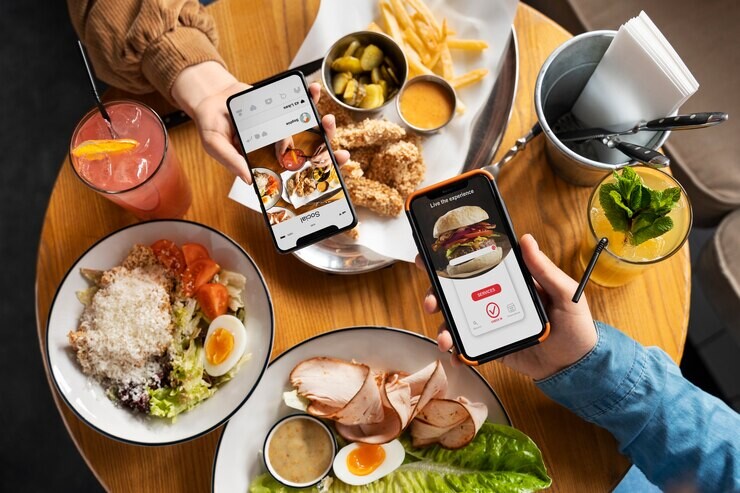
As consumer demands change, technology advances, and the global market shifts, so do the trends in restaurant operations. Understanding trends can help the restaurant industry stay ahead of the competition and remain profitable. It can also help the food industry identify growth opportunities and develop strategies to capitalize on them.
Let’s explore the top 10 current trends in the restaurant industry so you can make smart strategic decisions.
Here are the top 10 restaurant operations trends.
The pandemic accelerated the adoption of contactless ordering, and it’s here to stay. This trend isn’t just about safety; it’s about convenience. For supply chains and tech providers, this means investing in systems that support seamless, contactless payments. It’s not just a trend; it’s a transformation in how consumers interact with food services, demanding efficiency and hygiene.
Example: Services like Uber Eats and DoorDash have become increasingly popular as they allow customers to order food without having to interact with anyone in person.
Cloud kitchens, also known as ghost kitchens, strip down the traditional restaurant model to its bare essentials: the kitchen. This model is a game-changer for food manufacturers and distributors, as it shifts the focus towards quality and efficiency of delivery. It’s a lean approach to the food industry, minimizing overhead and maximizing the potential of delivery services.
Example: Cloud kitchens can cook and deliver meals in a fraction of the time and cost of a traditional restaurant, allowing food companies to focus on creating the highest quality products without sacrificing speed.
Sustainability is no longer a buzzword; it’s a business imperative. Effective food waste management is crucial, not just for the environment, but for operational efficiency and cost management. For everyone in the supply chain, from manufacturers to distributors, this trend emphasizes the need for smarter inventory management and more sustainable practices.
Example: Manufacturers can reduce their food waste by using efficient food production processes and accurate forecasting, while distributors can reduce their food waste by implementing better inventory management strategies.
Automation is revolutionizing delivery services. Delivery robots are not just a novelty; they represent a significant shift in how food reaches consumers. This trend is particularly relevant for tech companies and distributors, pushing them to innovate and adapt to a market that values speed, efficiency, and novelty.
Example: Amazon recently acquired a company, Zoox, to develop an autonomous car for last-mile deliveries.
With increasing consumer awareness and regulatory scrutiny, food safety is paramount. This trend goes beyond compliance; it’s about building trust and ensuring quality. For manufacturers and distributors, this means rigorous standards and transparent processes are not just recommended; they’re expected.
Example: Many food companies now implement HACCP and ISO 22000 standards to ensure food safety and traceability throughout the supply chain.
Artificial Intelligence is personalizing the customer experience, making it more interactive and responsive. This trend is reshaping restaurant tech, demanding solutions that are not just functional but intuitive, providing insights and interactions that are tailored to individual preferences and behaviors.
Example: AI-powered chatbots are able to provide personalized recommendations to customers with tailored offers based on past orders, customer preferences, and current restaurant trends.
The kitchen is getting a tech makeover, with robotic chefs bringing consistency, efficiency, and innovation to food preparation. This trend is a call to action for tech companies and supply chains to collaborate, creating solutions that enhance culinary creativity while streamlining operations.
Example: Companies such as Miso Robotics are working on autonomous robotic chefs that can prepare meals with the same level of precision and accuracy as human chefs.
Predictive inventory management uses data analytics to forecast demand accurately, ensuring optimal stock levels. This trend is a boon for supply chains and distributors, enabling smarter, more efficient operations and reducing waste. Predictive analytics can analyze customer behavior patterns and past sales trends to inform the stocking of items, resulting in fewer misses and fewer overstocks.
Example: Predictive analytics can analyze weather patterns, local events, and other external factors to determine customer demand for certain products and adjust accordingly.
The digital revolution is redefining the hospitality industry, extending far beyond online reservations. It encompasses every aspect of the dining experience, from digital menus to online reviews. For tech companies, this trend is an opportunity to provide comprehensive solutions that enhance every touchpoint of the customer journey.
Example: A restaurant technology company can offer a management platform that enables restaurants to manage customer reservations, payments, and loyalty rewards online.
The importance of maintaining the quality and freshness of food cannot be overstated. Enhancements in cold chain logistics are crucial for manufacturers and distributors, ensuring that products retain their quality from the kitchen to the consumer’s table.
Example: The use of temperature-controlled trailers and containers, as well as refrigerated trucks, has become increasingly popular in the food industry, ensuring that food is kept safe throughout the delivery process.
Restaurant operations trends are constantly changing, so staying ahead means leveraging trends strategically. You can navigate this dynamic market using Brizo FoodMetrics’ industry-specific market intelligence platform.
With Brizo FoodMetrics, you can get comprehensive, fresh, and accurate data on over 1.5 million foodservice establishments across the U.S. and Canada. With Brizo, you can analyze and understand the foodservice market with data-rich insights, it offers unparalleled market coverage, industry-leading refresh rates, and reliable, detailed insights that drive strategic decision-making, streamline operations, and reduce prospecting time.
Embrace data-rich, actionable insights and turn them into growth opportunities. Let Brizo FoodMetrics redefine your market strategy and streamline your operations.